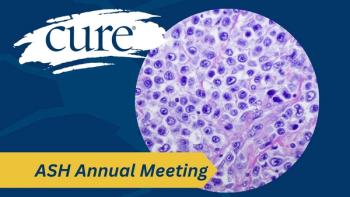
A ‘Turning Point’ for Metastatic NSCLC Treatment
Patients with metastatic KRAS G12C mutated non-small cell lung cancer now have another treatment option if they previously failed at least one line of therapy.
The Food and Drug Administration (FDA) recently approved Lumakras (sotorasib), a KRAS inhibitor for patients with metastatic KRAS G12C mutated non-small cell lung cancer who previously received at least one line of systemic therapy.
“The FDA approval of (Lumakras) … truly represents a turning point, an inflection point,” said Dr. Ferdinandos Skoulidis, assistant professor in the department of thoracic/head and neck medical oncology at The University of Texas MD Anderson Cancer Center in Houston and lead author of the phase 2 CodeBreaK 100 trial on which the FDA approval was based, in an interview with CURE®. “There is now an approved and accessible oral therapy that can shrink tumors and prolong survival without compromising quality of life.”
According to the FDA, KRAS mutations are identified in 25% of patients with non-squamous in non-small cell lung cancer, and the specific KRAS G12C mutation that is targeted by Lumakras accounts for an estimated 13% of all patients — approximately 1 in 8 patients. KRAS is a gene that regulates cell division and growth, and when it is mutated, it can lead to the development of cancer.
Before Lumakras was approved by the FDA, patients with KRAS-mutated lung cancer who failed first-line systemic therapy involving immunotherapy alone or in combination with platinum-based chemotherapy were typically treated with cytotoxic chemotherapy. Treatments were administered intravenously, required a patients to visit the hospital once every three weeks and were associated with significant side effects such as the risk of infections, nausea, vomiting and hair loss, “which has a big impact on their quality of life,” Skoulidis said.
In contrast, Lumakras is an oral therapy given at a 960-milligram dose once per day.
“The ability to take (Lumakras) orally as a pill will definitely improve the patient experience compared to the need to have a drug administered intravenously every three weeks with all the associated problems,” Skoulidis said. “The convenience of oral therapy is an important plus for patients.”
Side effects related to Lumakras, Skoulidis said, are mostly mild, reversible and manageable with standard-of-care supportive measures. The most common treatment-related side effects included diarrhea, nausea, elevated liver enzymes and fatigue. The label for Lumakras includes two specific FDA warnings related to liver-related toxicity, requiring regular monitoring of liver function tests, and pneumonitis (inflammation of lung tissue).
“Patients should be carefully followed, and if they develop any symptoms suggesting worsening respiratory status, (Lumakras) should be withheld and appropriate diagnostic evaluation should be initiated promptly,” Skoulidis said. “But overall, the drug was safe and certainly far better tolerated than what we’re used to with the standard-of-care cytotoxic chemotherapy in this setting.”
Skoulidis said future clinical development of Lumakras will focus on therapeutic combinations aimed at maximizing clinical benefit, efficacy as well as elucidation of molecular determinants of therapy response and mechanisms of innate and acquired resistance.
“The hope … is that once we have a deeper understanding of possible mechanisms of resistance to (Lumakras) this will lead to rational, effective and tailored combination regimens in order to either prevent the emergence of resistance or tackle it in the event that it has occurred.”
The approval of Lumakras may also be a call to action to perform more molecular testing for patients with metastatic non-small cell lung cancer.
“Access to broad molecular profiling is not equitable across the U.S.,” Skoulidis said. “Hopefully the first approval of a KRAS G12C inhibitor (Lumakras) will also increase the uptake of broad genomic profiling in community oncology practices to make (Lumakras) accessible to the broadest possible population of patients that it may benefit.”
For more news on cancer updates, research and education, don’t forget to





